“Interoperability” is a popular buzzword in the innovation space. But what does it really mean, and why is it particularly important in the world of innovation procurement? To help separate the fact from the fiction and bring some clarity to the process, we spoke to innovation procurement specialist Olaf-Gerd Gemein, to learn more about this important but also challenging topic.
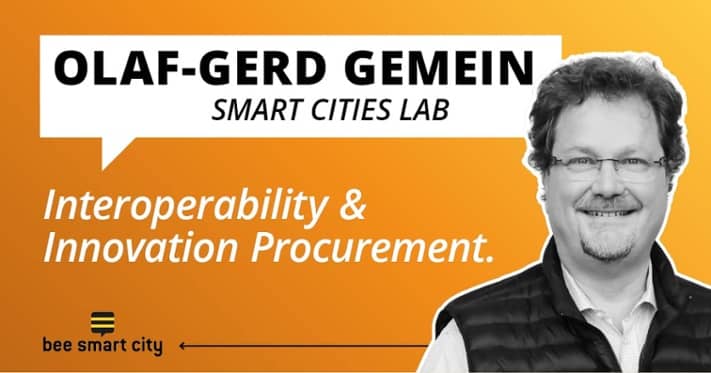
Olaf-Gerd is a Business Architect and Smart City Specialist with more than 30 years of practical experience and a portfolio of more than 100 successful projects. Originally a financial expert, Olaf-Gerd became involved in Smart City development in 2013 after working within the EU Commission’s crowdfunding regulation framework. From there, Olaf-Gerd has worked with some of the most successful business accelerators and incubators in the world, such as Speed-Up Europe. In 2016, he joined the board of directors at the FIWARE Foundation, before joining the Gaia-X community in 2020. Today, Olaf-Gerd is among the leading experts in Smart Cities and innovation procurement.
Here’s what we learned about interoperability and how important it is regarding innovation procurement.
When it comes to procuring innovation, there’s a lot to consider about “interoperability.” What is interoperability and what does it really mean?
Interoperability is a broad and often misunderstood topic that is sometimes confused with connectivity. They are related, but they are not the same thing. Connectivity is part of the basic operation of interoperability, and interoperability needs connectivity to function, but interoperability means more than that. Interoperability is more than just how to access data and how that data flows between applications, it also relates to the meaning behind the data, the semantics behind it, the rules of data usage, and the policies that govern it.
The benefits of interoperability come when you have a smooth and transparent way of solving a problem, can fully understand what that data really means, and of course, can use that data within an organized, and thus meaningful, data flow.
So, it’s like an API?
Not really. APIs, or automatic programming interfaces, are just one part of wider interoperability. And interoperability is also just one small piece of a wider goal. With successful interoperability, we also support and achieve portability and replicability. Because when you have interoperability in place, which is still not the case with most digital applications, but in the future when we have stable and advanced interoperability between the basic fabric of our digital systems, then we can really replicate solutions in different environments and enact rapid changes.
For example, the goal of data interoperability is that data flows from one point into an accessible data space, and that data can be used by a procurer, consumer, or prosumer, who can understand the meaning of that data and use it effectively.
“Data space” - isn’t that just the same as a “data silo”?
At the moment, or rather over the last 25 years, everyone said “oh, your data is siloed and that is very bad because your data cannot be connected, reused, or repurposed,” but I think that’s not quite true. Right now, we’re experiencing a shift. In fact, it’s a good thing that data is saved in a silo, as it’s maintained by those who have the best knowledge about the best use cases for this data, and they know how to store it and care for it. The real challenge isn’t to break down data silos anymore, but how to better orchestrate these data silos.
It’s not about inventing a single platform like Google or Alibaba, with a one-takes-all concept with a platform intermediary in the middle that everyone has to go through. This vision is completely out of favour. Instead, we’re actually talking about the orchestration or federation of diverse data varieties, such as data bundles that include different algorithms and APIs.
In short, everyone can keep and care about their data within their existing siloes, but there is a way that data can be accessed and flow from one place to another, using uniform policies, rules, and mutually agreed on technical specifications. That is the goal, prerequisite, and meaning of interoperability.
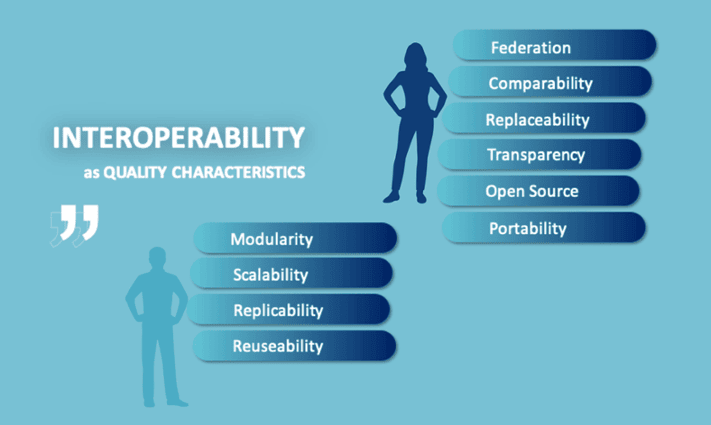
Of course, interoperability looks different from the procurer’s side compared to the solution provider’s side (see figure above). From the procurer’s point of view, interoperability is ideal because you can reuse (and compare, replace, or port) it. However, for some solution providers, interoperability is…well, they hate it! This is because some providers can use interoperability and scale it for the benefit of everyone, whereas others, like your GAFAs (Google, Apple, Facebook, Amazon), or Microsoft and IBMs, the big players, need to dominate a market and cement themselves firmly within it, and effectively lock out competitors with proprietary data.
Interoperability could negatively affect their business model and its absence is incorporating a kind of moat around their castle. But, as shown above, there are 4 clear benefits for the supply-side: Modularity, Scalability, Replicability, and Reusability.
And is this why we need more innovation procurement? Where is the link between innovation and interoperability?
Innovation procurement is good for those who want to work in a collaborative way, who understand that if we work together, combining skills, knowledge and technology, we can solve ever more challenging problems. This generally helps solution providers create smarter systems and better products, suited to a wider range of customers. For example, if you follow the rules of interoperability (including standards), really smart solutions can be developed and sold to more than just one customer. A great solution can then be marketed to hundreds of customers, such as cities, and many other potential major industries, based on the economics of scale – and this is true for verticals (domain-specific) and horizontal (generic) implementations.
The recent ruling in the EU about phone chargers is a good metaphor for interoperability. Now, manufacturers must make phones that work with one kind of universal charging port. This prevents vendor lock-in and makes life easier for consumers. With a universal phone charger, customers are no longer beholden to one manufacturer’s products. The same is true with interoperability when it comes to data ownership and open innovation. If all innovators are working to the same standards, there’s a kind of transparency that everyone benefits from.
That’s the beauty of interoperability. If you follow the standard requirements and apply the right set of criteria, such as the license, the semantics, technical specifications, and the architecture, then everyone benefits – but such mutual agreements are still hard to achieve.
To compare the existing landscape of standards and best practices, the Pivotal Points of Interoperability (PPIs) concept is particularly helpful. The image below shows a method for approaching consensus among stakeholders, to agree on "common ground" in areas of high complexity and diversity. This approach is well-founded and has been used successfully before in the context of “standardisation” and stakeholder alignment. The process has five steps, starting from architectures and deployments, ending with a document about the “interoperability” touchpoints.
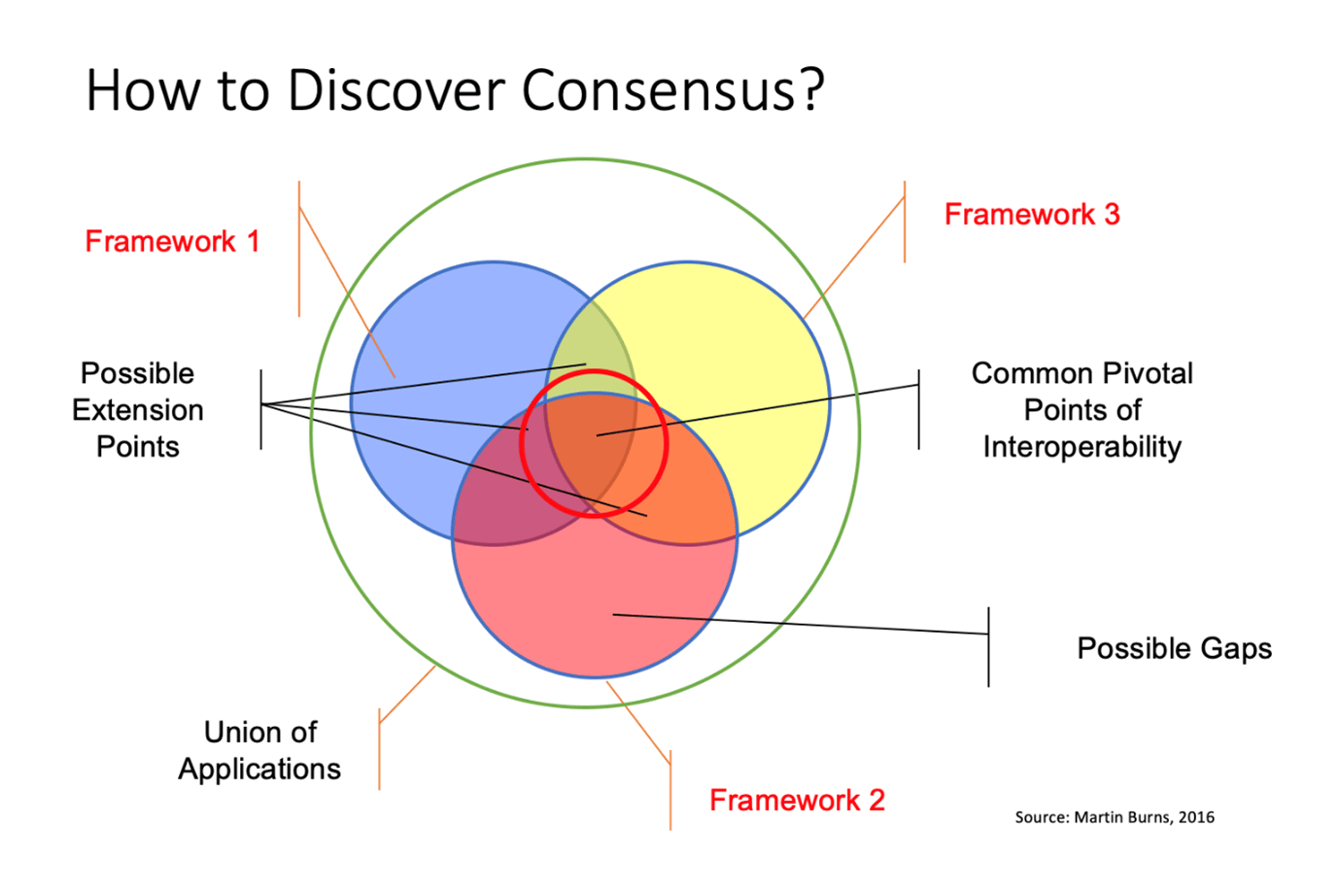
Considering the benefits of interoperability and innovation procurement in general, why isn’t this a more popular procurement method?
Because governments fear change and any potentially negative consequences. Here’s a good positive example. In Finland, 5% of the public budget must be spent on innovation procurement by law.
5% may not seem like much, but for governments, it’s actually quite a lot. With that 5%, governments can try new things and procure solutions with no “set” predefined requirements, with an open mind, and room for flexibility. It’s quite forward-thinking and it allows governments to take risks that they usually couldn’t or wouldn’t. It makes innovation procurement easier.
For example, the procurer publishes a challenge, not a defined list of requirements. Consequently, responding suppliers are free to propose the best – and most likely new and innovative – solution; because “you cannot know what you don’t know” – means you cannot request, require, define and procure unknown solutions. But that’s the best case study that I know, in Finland. There aren’t many other governments embracing this mindset or rules, but it's slowly spreading across the globe.
In other countries, there is something of a shift in this direction, but it takes time and practice. You need platforms like bee smart city to help city procurers to understand the potential of innovation procurement and help cities take a gamble with innovation procurement. It’s a process that takes many city officials out of their comfort zone, and it’s quite radical.
For many cities, there is no defined template for this kind of process and radical ideas like this often require legal advice and bureaucracy that slows it all down. I’ve experienced this more than once here in Germany.
Would you say this is a typical German problem or does it apply to other countries too?
It certainly is a specific German behaviour, but it’s a global problem too. Sure, it has a touch of German angst about it, but it’s a pattern that I’ve seen in a lot of other countries. “Never stop a running system” is particularly true for governments, “Never risk failure during an innovation journey” is still the rule which applies for the majority of governments. This is directly opposed to the most innovative of entrepreneurs who work to a “fail fast and improve” motto.
What cities are currently embracing innovation procurement?
Of course, there’s the Finnish, who have really embraced innovation procurement. The work done by the Finnish is widely promoted by the government and well-documented by the EU Commission, so there are a lot of good stories to read coming out of Finland.
I think some great examples worth investigating include Ghent in the Netherlands, the German cities of Munich, Dresden, and Kiel, and other cities in Finland and not just Helsinki.
In Kiel recently, as part of an EU funding project under the Connected Europe Framework, a collaboration of 15 cities, universities, NGOs and innovative SMEs are building the cities first interoperable, integrated and replicable city-wide dataspace. This project will mean that the city will own its data, transport air quality, energy, etc, and will subsequently be able to specify the principles of interoperability into any government innovation procurement process. This is a significant change in capability and means an end to reliance on global corporates dominating civic service provision.
Over in the US, cities like San Jose and San Francisco are quite forward-thinking. They have a lot of innovation procurement challenges running over there. There’s a working group on GCTC (Global Cities Team Challenge) who have worked with Sean Rice, Chris Forman, and Joe Carella. They have done a lot of good innovation procurement in North America, but that’s about it. There are not so many places that are really embracing the process yet at scale, but things are changing, and we should keep our fingers crossed.
The below figure shows basically, how interoperability is a prerequisite to innovation procurement, starting from the PPI (pivotal points), MIM (minimum interoperability mechanism), and MIOS (Collateral of Standards) all together forming the ground to procure innovative solutions. These three consecutive steps form the safe basis, on which an “open”, not yet defined solution, can be requested, and still be aligned with the dedicated procedures set in the standards.
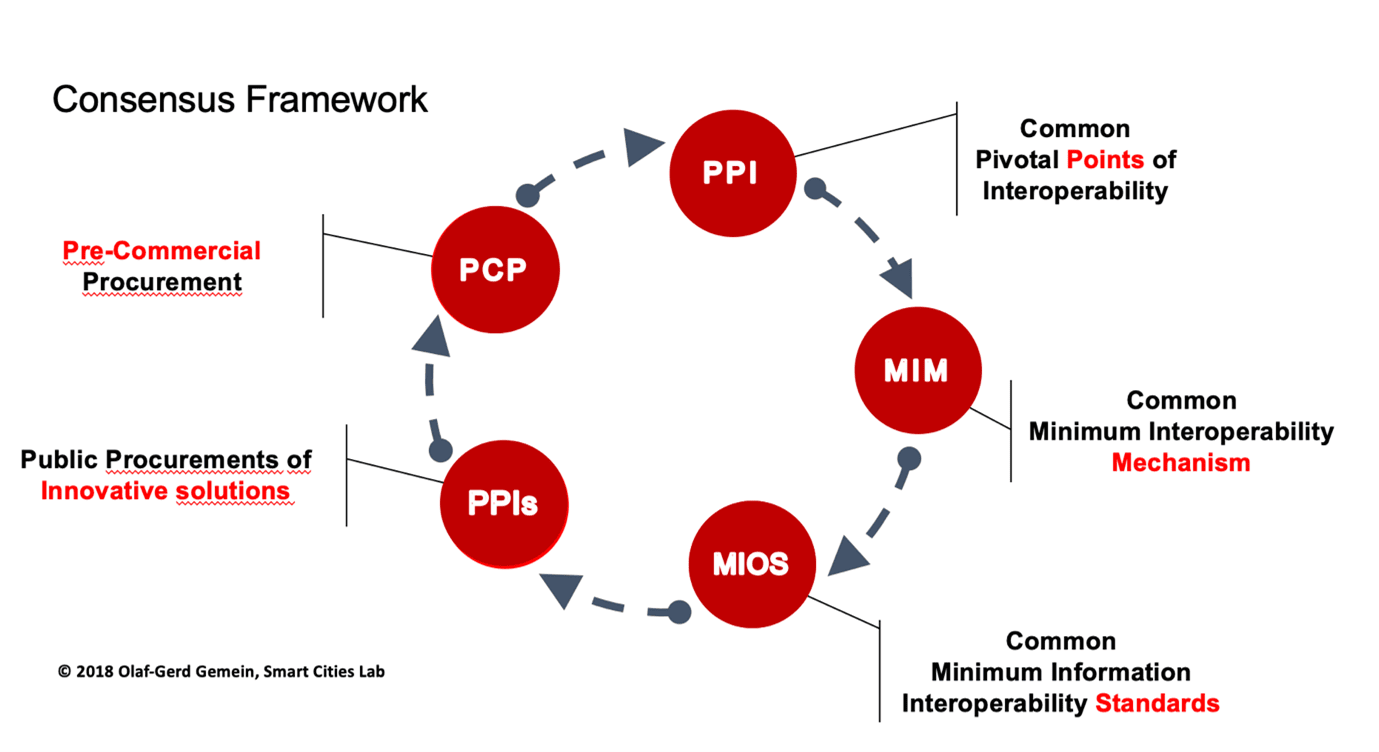
Finally, how would you highlight the importance of innovation procurement?
Personally, I don’t recommend being an innovator - you can’t sleep! You’re constantly being driven to do things that have never been done before. It’s really challenging. Innovation is always needed, so we really need to encourage, care and nurture innovators who are prepared to take these kinds of risks and do the hard work.
From a procurement point of view, we need to develop safe, smart, and legal strategies that can allow governments to take risks (not only financial, but other risks too, as products and services may fail), giving engaged and smart innovators a space where they can develop ideas, build products and test, with the freedom to act – and fail. Below is an example of how an innovation procurement process can be used by local governments in the form of a smart city innovation challenge.
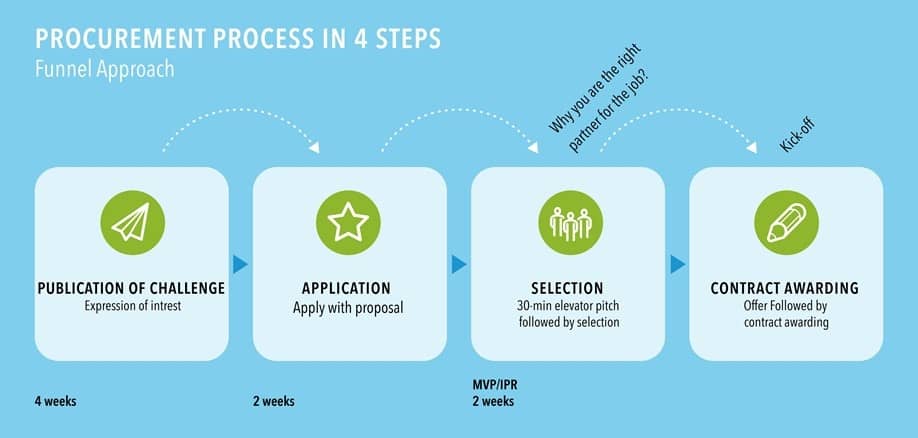 In summary: If you give entrepreneurs and innovators the room to create novel solutions and grow, with a framework to protect them from global mega-corporates, great things will happen. The best innovation appears from the collaboration of stakeholders across industries and domains. With smart innovation procurement strategies underpinned by interoperability, we can enable this.
In summary: If you give entrepreneurs and innovators the room to create novel solutions and grow, with a framework to protect them from global mega-corporates, great things will happen. The best innovation appears from the collaboration of stakeholders across industries and domains. With smart innovation procurement strategies underpinned by interoperability, we can enable this.
If public sector procurement is a key topic for you as a solution provider, then you should start a trial of our Tender Premium Service to access the latest smart city tenders issued around the globe. Set your preferences and be notified about suitable tenders for your company. No strings attached and completely free for two weeks.
Read related articles:
- Tendering 101: Understanding the tendering process
- How to Win a Smart City Tender: 5 Key Success Factors
- Talking Open Source and Open Data with FIWARE CEO Ulrich Ahle
- The Benefits of Urban Data Platforms for Smart City Development
- Explore more Smart City Strategy Articles


